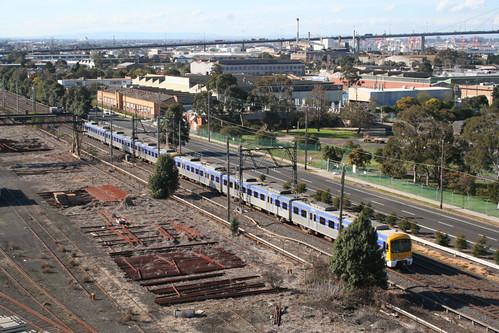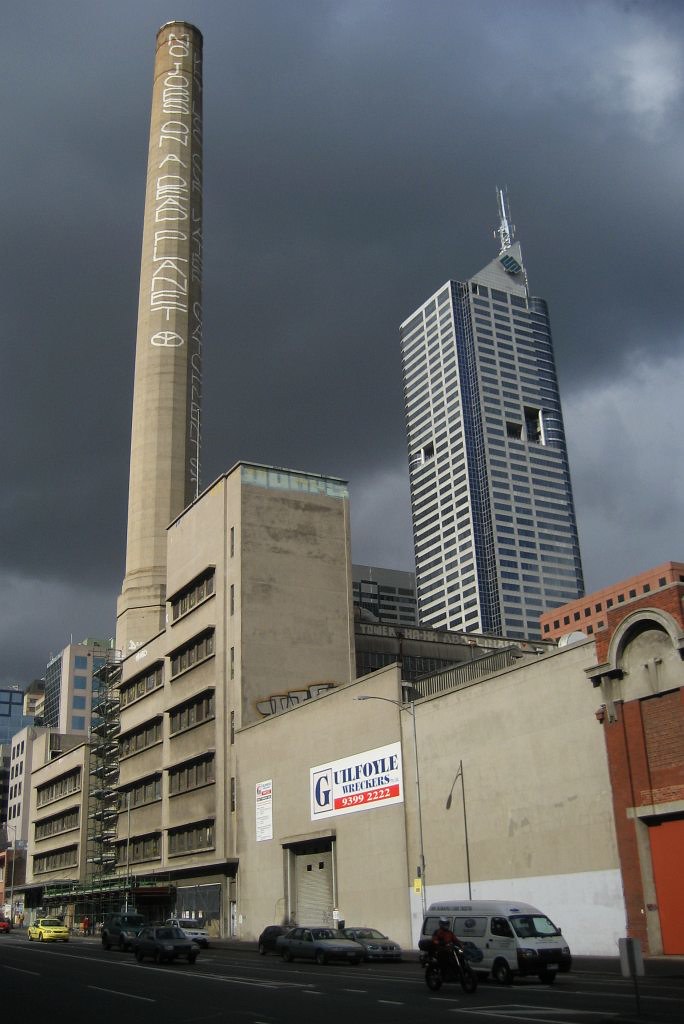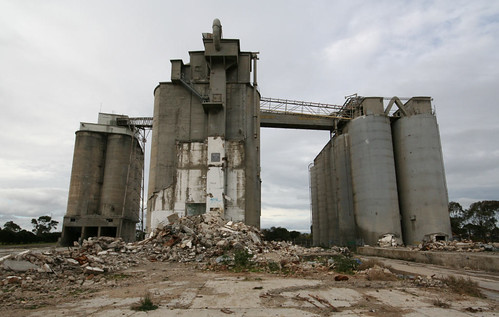Another instalment in my photos from ten years ago series – this time it is August 2007.
We start at North Melbourne looking towards a sparser looking CBD skyline.
This flyover was previously only used by standard gauge passenger services and light engines accessing the locomotive depot at South Dynon, but has since been rebuilt as part of the Regional Rail Link project to allow V/Line trains to access Southern Cross without conflicting with suburban trains.
Around the corner I paid a visit to the Melbourne Steel Terminal, where steel products were transhipped between broad and standard gauge trains.
The terminal was last remaining part of the vast Melbourne Yard complex that stretched between the Melbourne CBD and the docks, but no longer exists – the land earmarked for the new ‘E’ Gate development.
Over at the South Dynon locomotive depot I saw a pair of CLP class units.
These units were retired from mainline service by owner Aurizon in 2012 then put up for sale overseas, but are still sitting in store at Goulburn in NSW.
I also found a pair V/Line locomotives in the red livery of the period.
Then found them again later in the day, with a set of carriages between them.
For the past decade the P class locomotives have been used in pairs on ‘push–pull’ trains, a mode of operation that has come to an end following the August 27 V/Line timetable change.
Another everyday V/Line sighting was this Geelong bound train passing through the Werribee Street level crossing south of Werribee.
Since 2015 the level crossings now sees just a handful of trains a day – Geelong services now use the Regional Rail Link tracks to the west.
But a far more unusual sighting was this two carriage long V/Line charter departing Southern Cross.
The brown carriage is dining car ‘Avoca’ – on loan to V/Line from the Seymour Rail Heritage Centre, who restored the carriage to operational condition. Avoca entered service in 1927 and remained in use until the 1980s, when it was replaced by the smaller ‘snack bars’ currently found on V/Line trains.
This month I also scored a tour of the railway workshops at Newport. There I saw locomotives under heavy overhaul.
Wheelsets getting reprofiled on a lathe.
Bogies being lifted in the bogie shop.
Massive locomotive engines getting reconditioned.
And a pile of spare fibreglass front fairings for the Comeng train fleet.
I also ended up at the top of the former WC Thomas & Sons flour mill in Newport, which gave me a great view of the trains down below.
As well as the sidings next door.
Demolition commenced in early 2017, with much of the site already gone.
Another long abandoned Melbourne building was the Spencer Street Power Station at the corner of Spencer and Lonsdale Streets.
After laying idle for decades demolition commenced in September 2007, being fully cleared by April 2008 with apartment towers now occupying the site.
But one abandoned site that lives on is the former Fyansford Cement Works.
The cement works closed in 2001, with the bulk of the site demolished in 2004, but the concrete silos atop the hill still remain in place today.
More photos
- Touring the Newport Workshops
- Exploring the former Fyansford Cement Works
- Derelict flour mill at Newport
Footnote
Here you can find the rest of my ‘photos from ten years ago‘

















AVOCA & HOPKINS – 1927 to now.
Hopkins and Avoca were all steel, fully riveted, 48 seater dining cars built by the Victorian Railways in 1927, for use on the Melbourne to Ararat section of “The Overland” and also on the “Spirit of Progress” (as stand-by dining cars). They were said to be the very heaviest VR passenger cars ever built and had a concrete panel within the underframe for stability. Both cars were a WHOPPING 75 tons each!!!
Avoca and Hopkins were “sister cars” and largely displaced the three “E” series express dining cars:- Goulburn, Wimmera and Campaspe that were all modified for different uses. Goulburn became a crew and utility car; Wimmera became the Medical, Vision & Test Car and Campaspe became a Hospital Car and later the crew accommodation on the North Melbourne, later South Dynon Loco Depots Breakdown Train.
The Avoca car was issued to service April, 21, 1927. It was fitted with suburban Tait M channel frame bogies which had suitable axle boxes for the heavyweight car. The change to roller bearing bogies was probably done in the early 1960’s. After falling into little use she became the Dining Car on the “Train of Knowledge” (The School Train). In May of 1984 she was also given the code number RS 235. In the summer of 1984/85 Avoca was refurbished for continued use upon the Train of Knowledge.
The ToK was decommissioned upon arrival back from Bairnsdale on Friday the 1st of December 1989; “S” circular 89/4251. Locomotive was X 41, 10 cars for about 433t; Locomotive Crew were both Drivers: Kevin Whelan (Commissioners’ Driver) and Co-Driver the late Mr. Danny Hallinan; Passenger Guard was the late Mr. John Collier. After this, “Avoca” had no regular jobs and was hired out from time to time by V/Line.
The Victorian Health Department de-accredited the galleys (kitchens) on essentially ALL VR heritage dining cars and the 2nd Norman car in the early 2000’s. This made hiring out the cars much more difficult as there was no capital finance to refurbish the galleys on our aging heritage fleet.
The Hopkins car was issued to service June, 21, 1927. It too was fitted with suburban Tait M channel frame bogies which had suitable axle boxes for the heavyweight car. It was sold to the Commonwealth Railways in February, 1950 and re-classified “DB 75” by the Commonwealth Railways. At this time it was air-conditioned and used on the Trans-Australian and later the standard gauge “Ghan” connection from Port Pirie to Maree. Hopkins was fitted with CR “BK” type bogies on December 1, 1954. It was written off by the Commonwealth Railways on March 29, 1968.
Sean Kelly.
Why would the change of timetable bring about the end of push-pull?
Transferring steel from broad gauge to standard gauge! Still the repercussions of the break of gauge go on.
Why would the change of timetable bring about the end of push-pull?
Back in the early 1980’s the ORIGINAL CONCEPT with the “P” class rebuilds and rebuilt Harris Cars was to run “overseas style” with the locomotive PERMANENTLY attached to one end and the rear car being rebuilt as a driving trailer.
Union opposition to this plan as they thought it would bring about Driver Only Operations put an end to the scheme.
Instead we ended up with what we have now. P + H set + H set + P.
This takes a LONG TIME to “set up” and pull apart twice per day and requires a two man crew both times so the service is economically “doomed”. On top of that the 13 “P” class, 8 in VLP service are now about 33 years old in rebuilt form and their frames are 61-62 years old. The “P’s” are getting “very long in the tooth” (old)!
We will probably see them return to service from time-to-time as there are not really enough V’Locity sets to cover the work with V’Locities out of service due to maintenance and accidents. Rather like A 66.
Transferring steel from broad gauge to standard gauge! Still the repercussions of the break of gauge go on.
Yes This is true. In about 1990 under Prime Minister Paul Keating’s “One Nation” funding scheme for infrastructure, when monies were make available for the “National (rail) Freight Initiative”, the plan was to standard gauge Adelaide to Melbourne and provide a standard gauge route from Melbourne to Lyndhurst via Oakleigh and Dandenong. From Lyndhurst the “new standard gauge line” would have run across country and hooked up with the Stony Point line south of “Langwarrin bank” and provided full standard gauge direct to Westernport and the (then) BHP rolling mill.
With the one remaining “blast furnace” in Australia “under a cloud” (even with the recently announced buy out and rescue of Arrium at Whyalla who are 4.2 Billion $$$ in debt); there is little enthusiasm to provide standard gauge to “Long Island” as the entire Nation’s steel manufacturing business may collapse.
As a note of trivia, the 2 x cranes that do the transhipment in the Melbourne Yard are ex the Adelaide Islington Intermodal (container) Terminal where they used to perform the same task up until gauge conversion from Adelaide to Melbourne in 1995. In Adelaide the cranes had painted names on them:- “Bill” and “Ben”. These two cranes were also about 25% TALLER when in Adelaide! For some reason when they were transferred to Melbourne Yard they had their original legs SHORTENED and are now the existing height they are today.
Hope this helps?
Sean Kelly.
Thanks for all the interesting detail, Sean. I believe there are more V’Locity trains ordered and being delivered, so these older trains will disappear in the not too distant future.
Andrew,
Thank you for the “thanks”; I really appreciate it. Have a great day!
Sean Kelly.
Thanks for the extra info about the 1990s ‘One Nation’ standardisation program –
https://en.wikipedia.org/wiki/One_Nation_(Infrastructure)
Some more detail on the works actually completed are here:
http://railknowledgebank.com/Presto/content/GetDoc.axd?ctID=MTk4MTRjNDUtNWQ0My00OTBmLTllYWUtZWFjM2U2OTE0ZDY3&rID=NDU4Mw==&pID=Nzkx&attchmnt=VHJ1ZQ==&uSesDM=False&rIdx=MzU1Mg==&rCFU=
An interesting topic for me to investigate further!
what trains now operate the services which were once hauled by the push-pull’s?
I believe it is a mix of 6 car H sets behind N class locomotives, or VLocity trains.
Another note the Fyansford rail yard was cleaned up rail contractor under a Victrack contract with plans to later turned into a walking track (or just simply made safe from tripping hazards) sometime mid 2010, with the two removed turnouts and truck load of serviceable woodern sleepers and possibly (can’t remember) some lengths of rail dontated to Bellarine Peninsula Railway.
Incidentally a few months later on a simplar contract the same contractor was called to remove the rails around Koo Wee Rup station precinct.
Some more detail on the Fyansford line being lifted here:
https://www.railpage.com.au/f-p1508015.htm#1508015